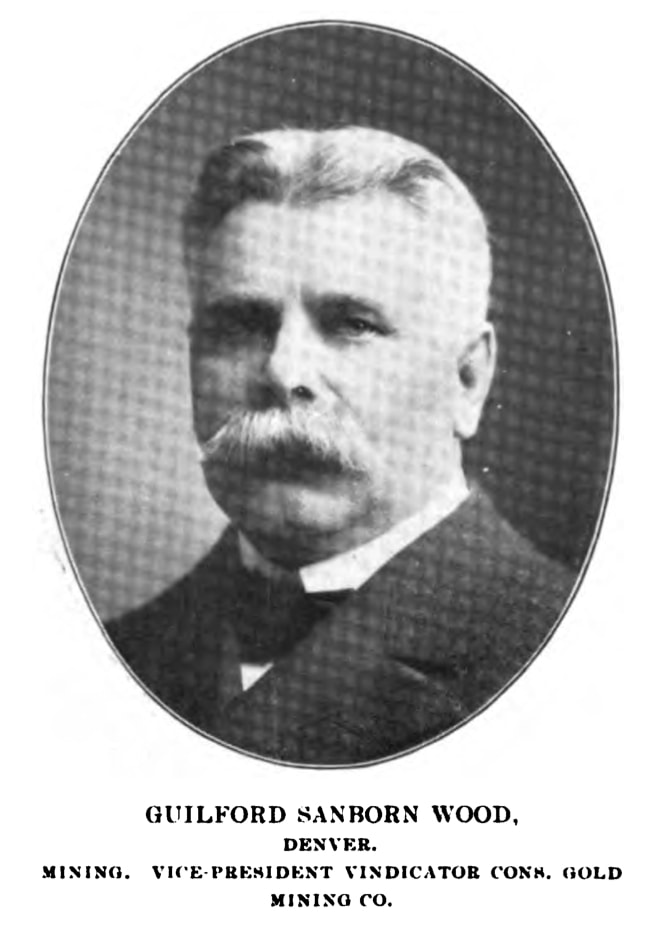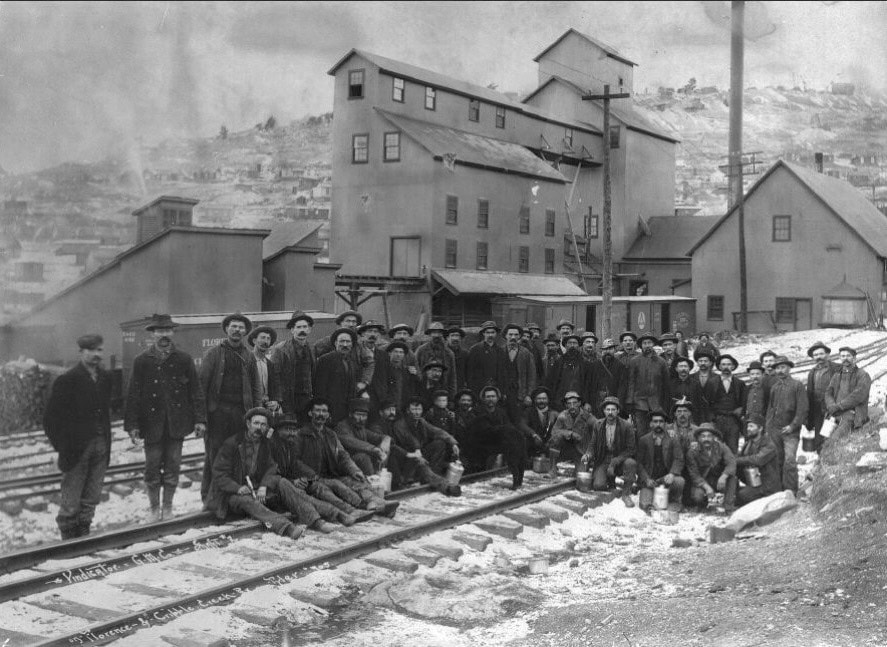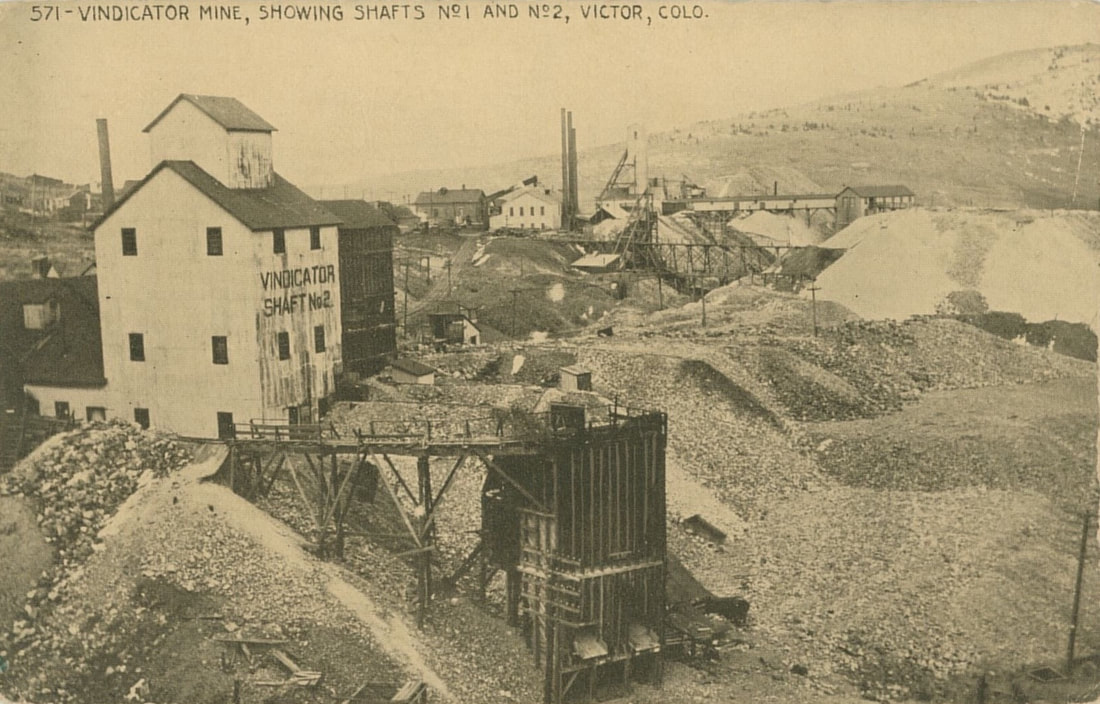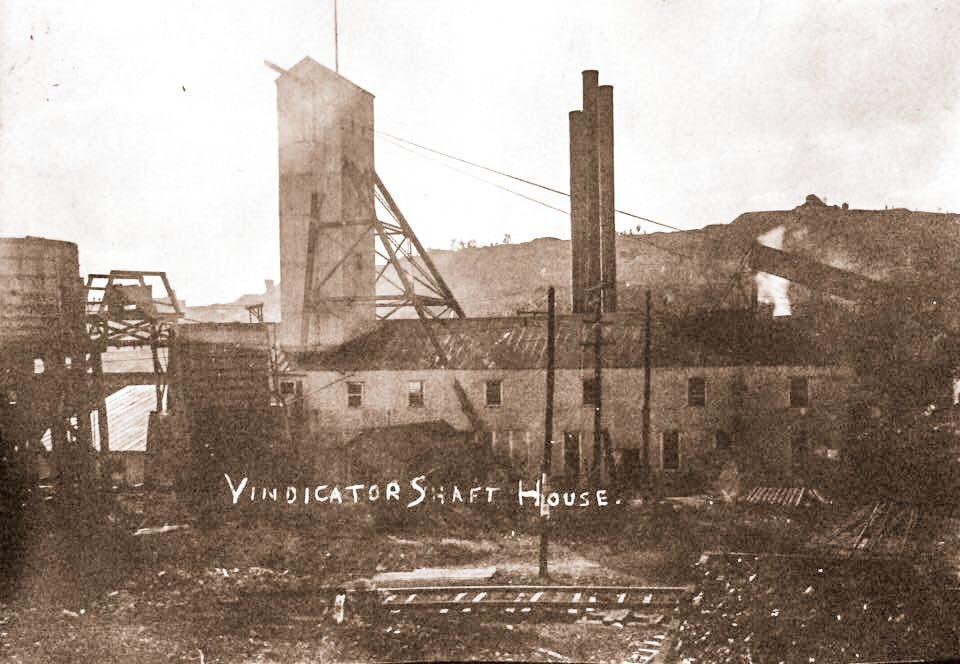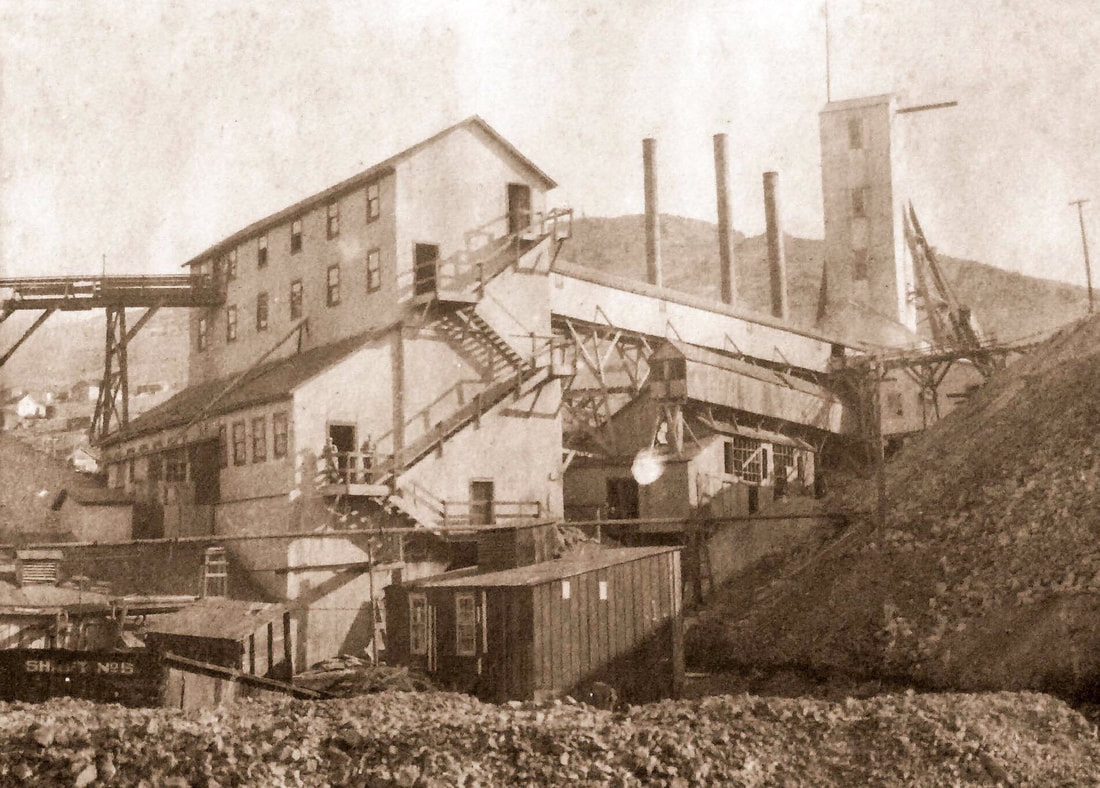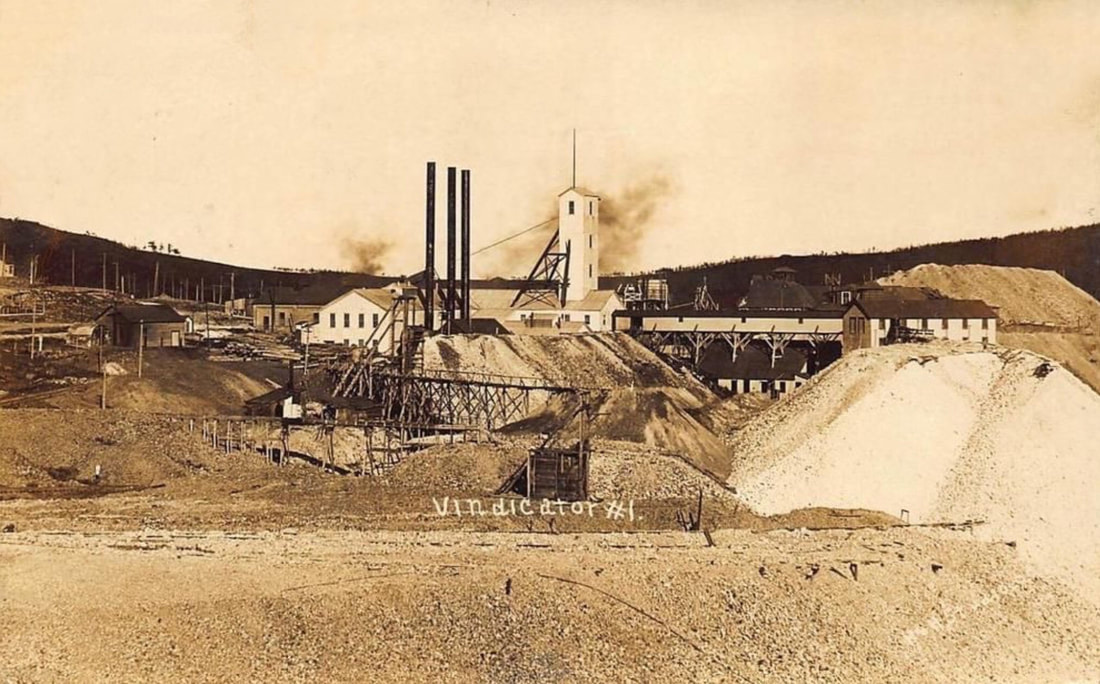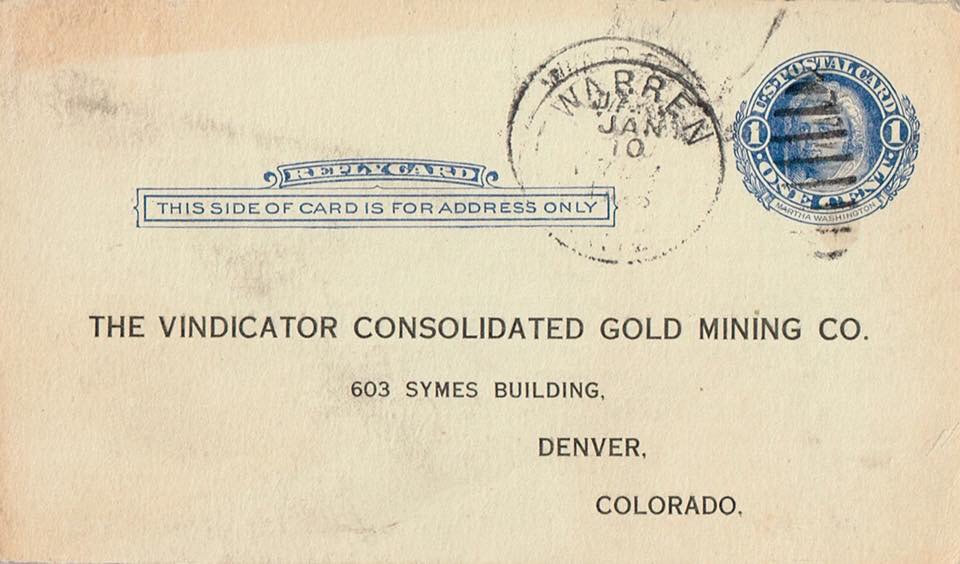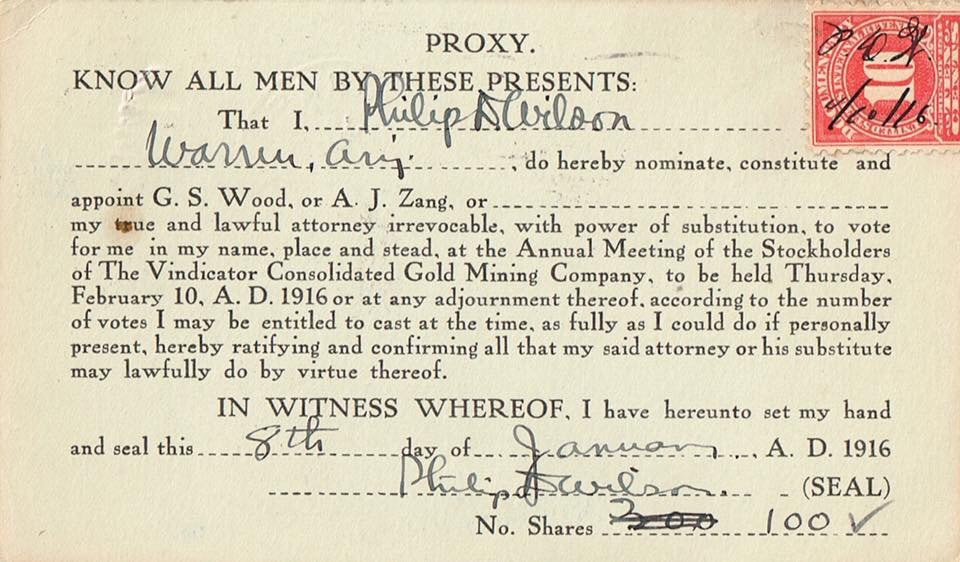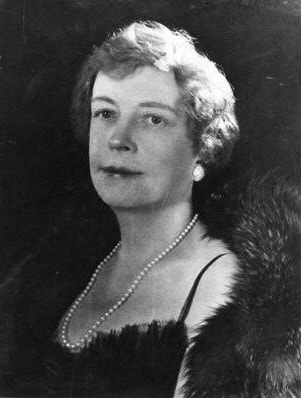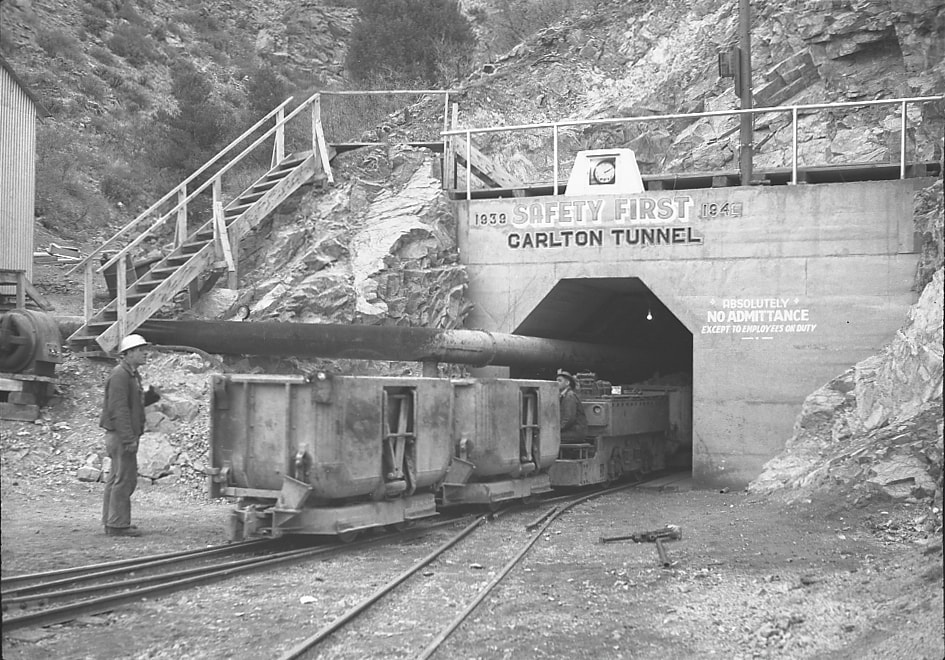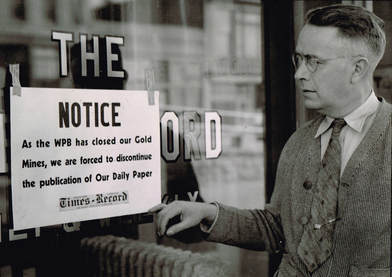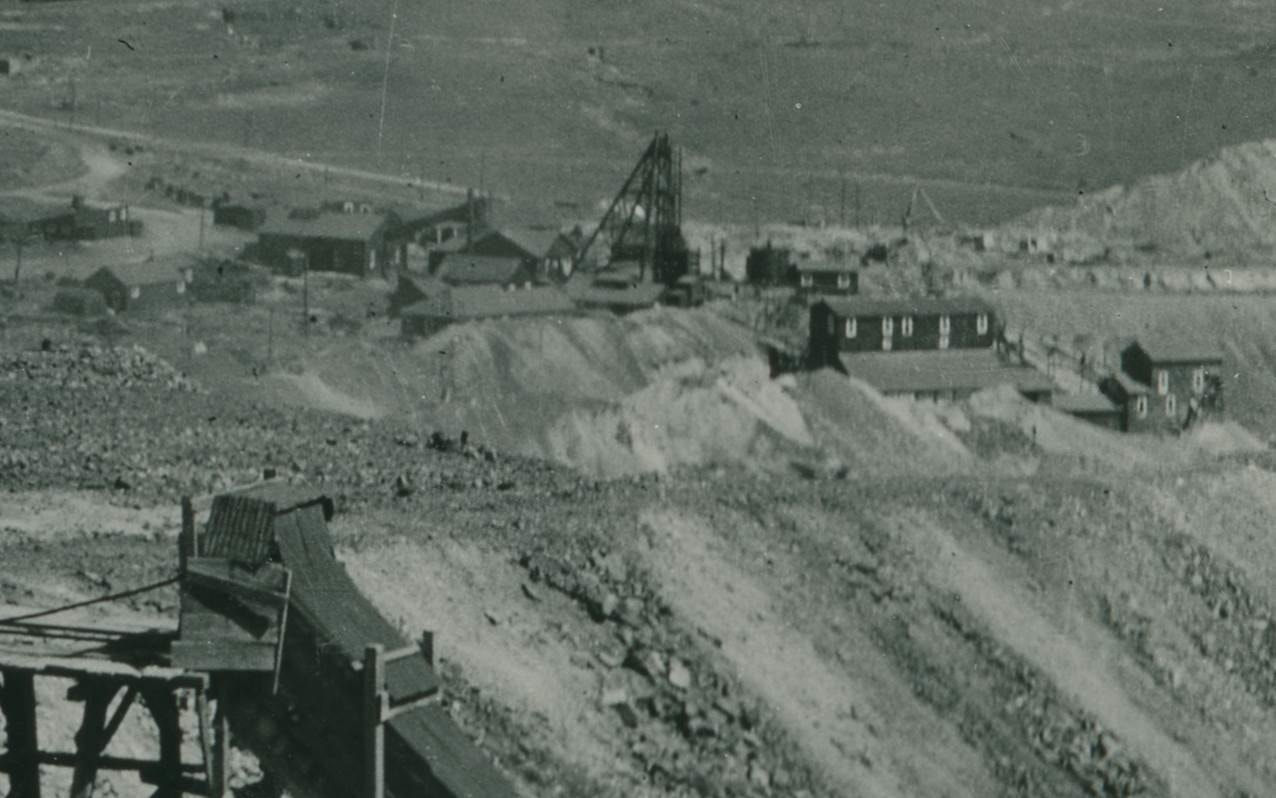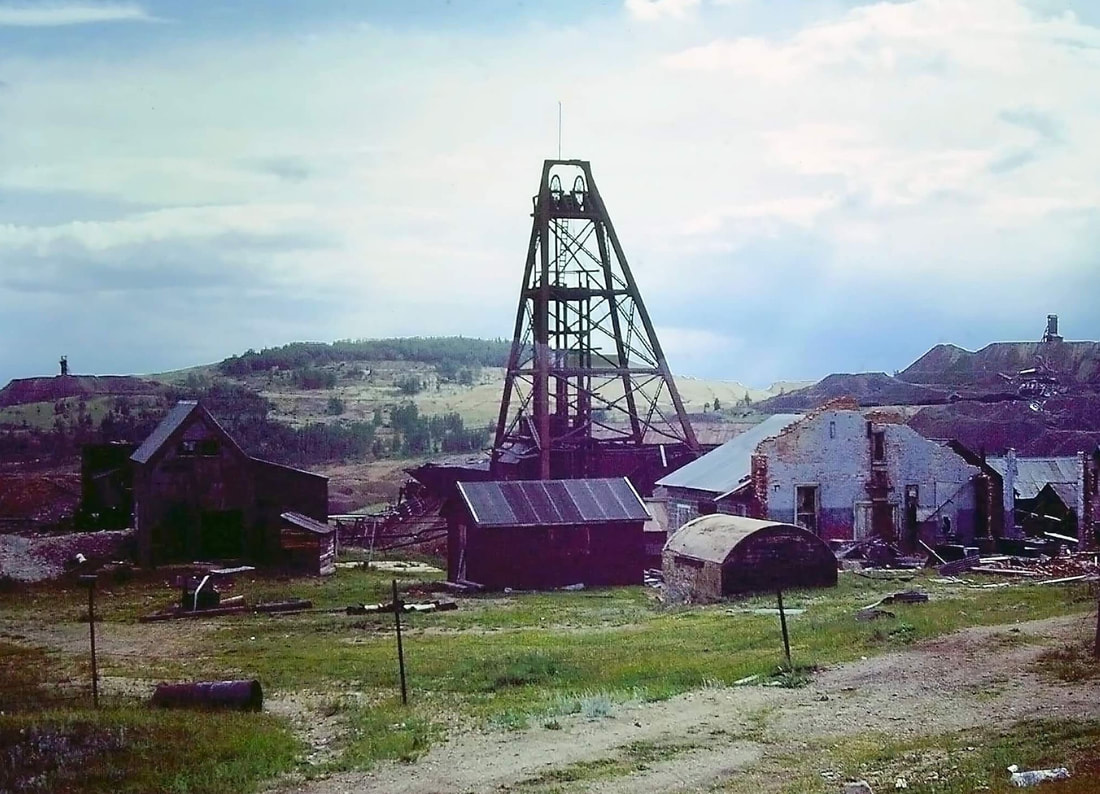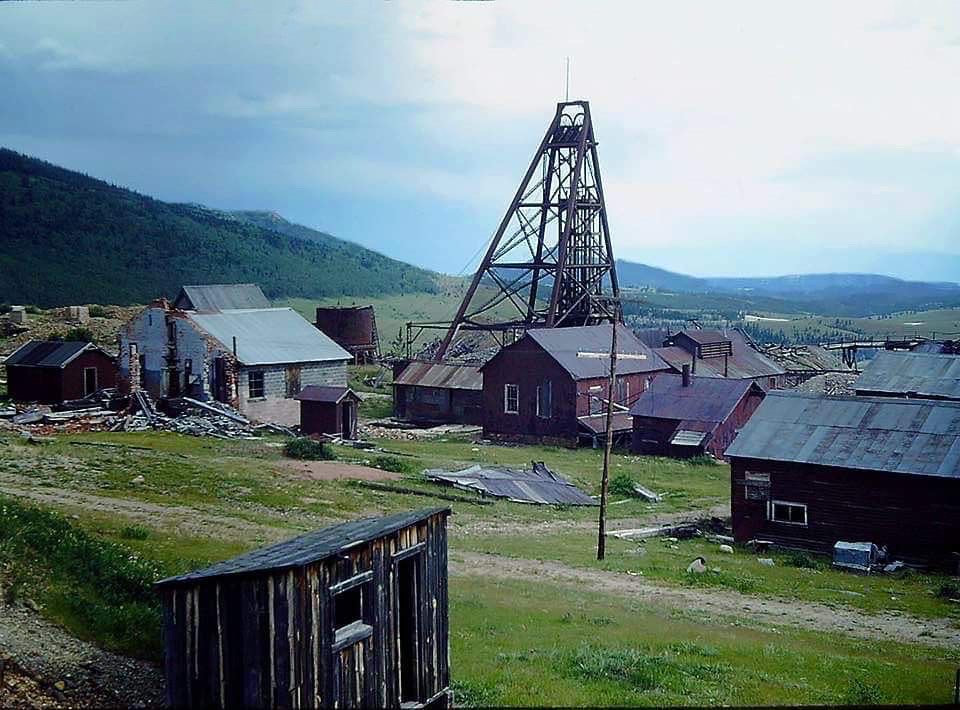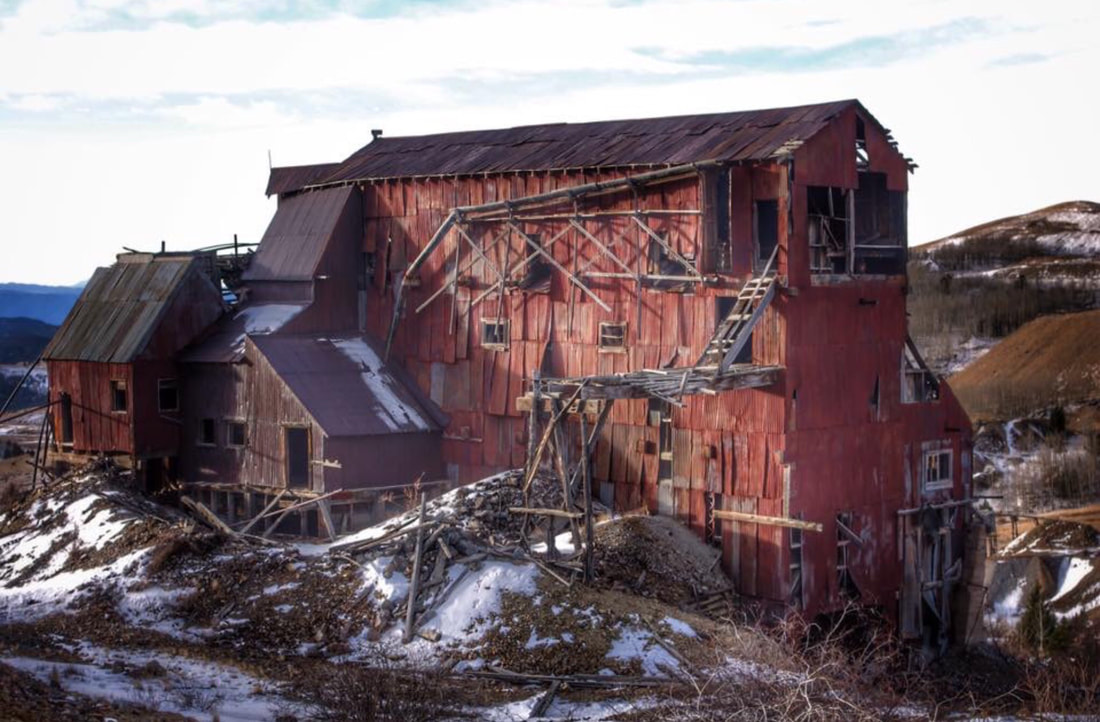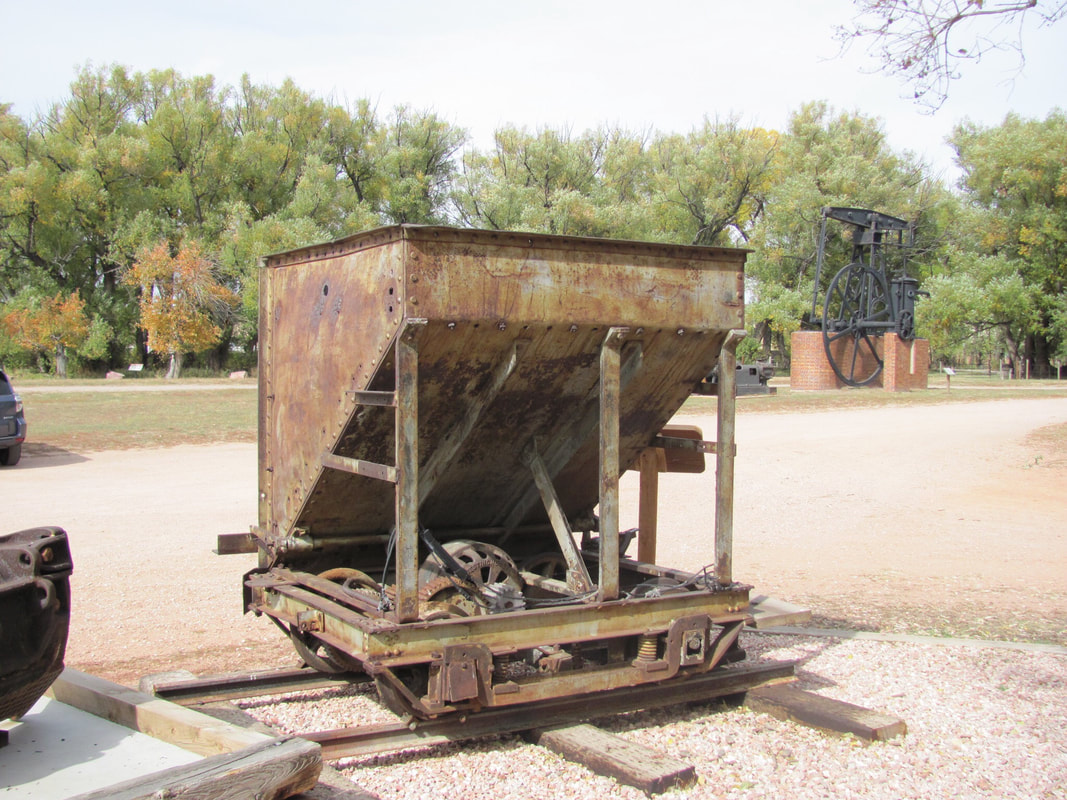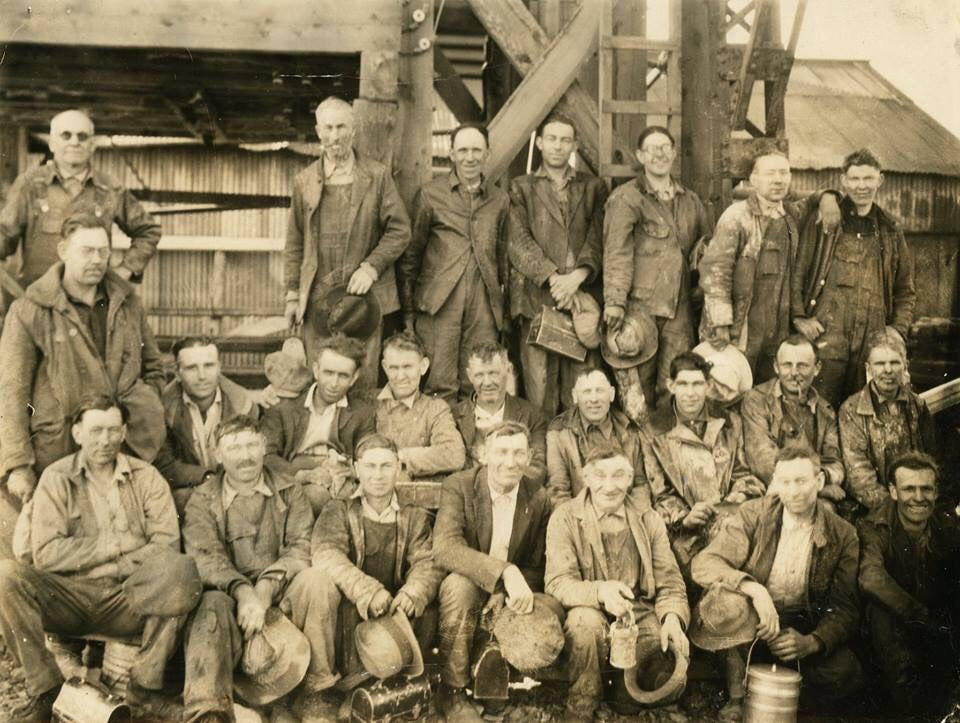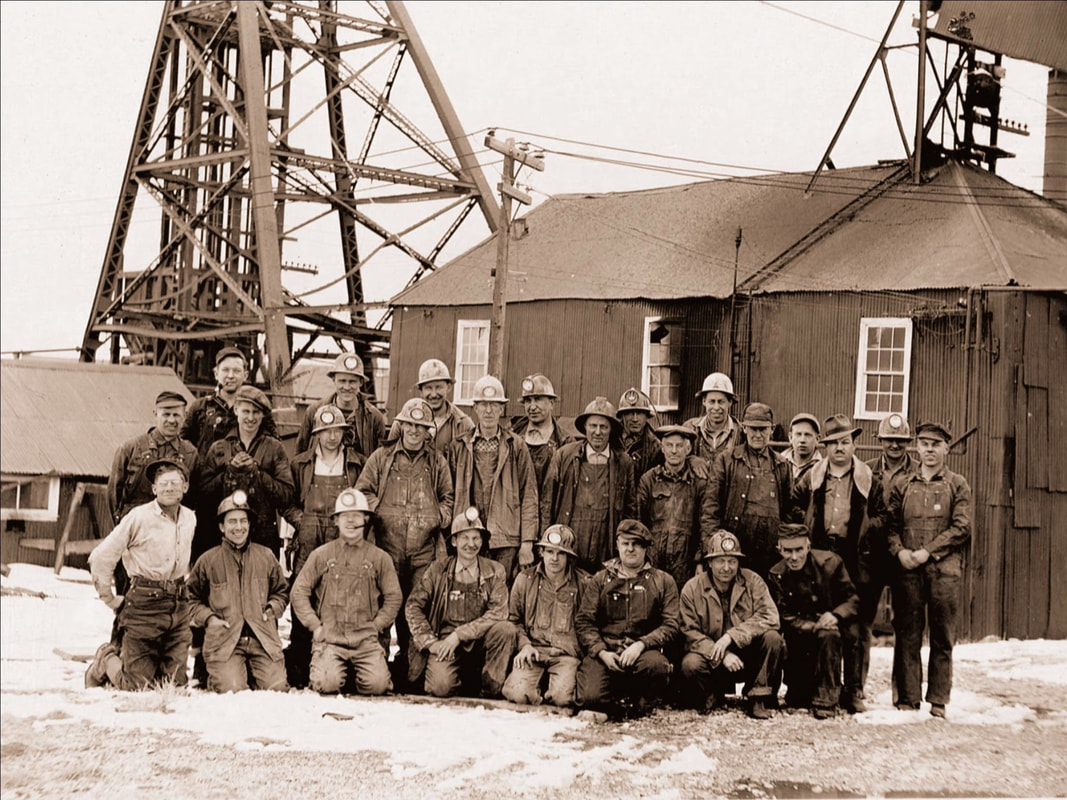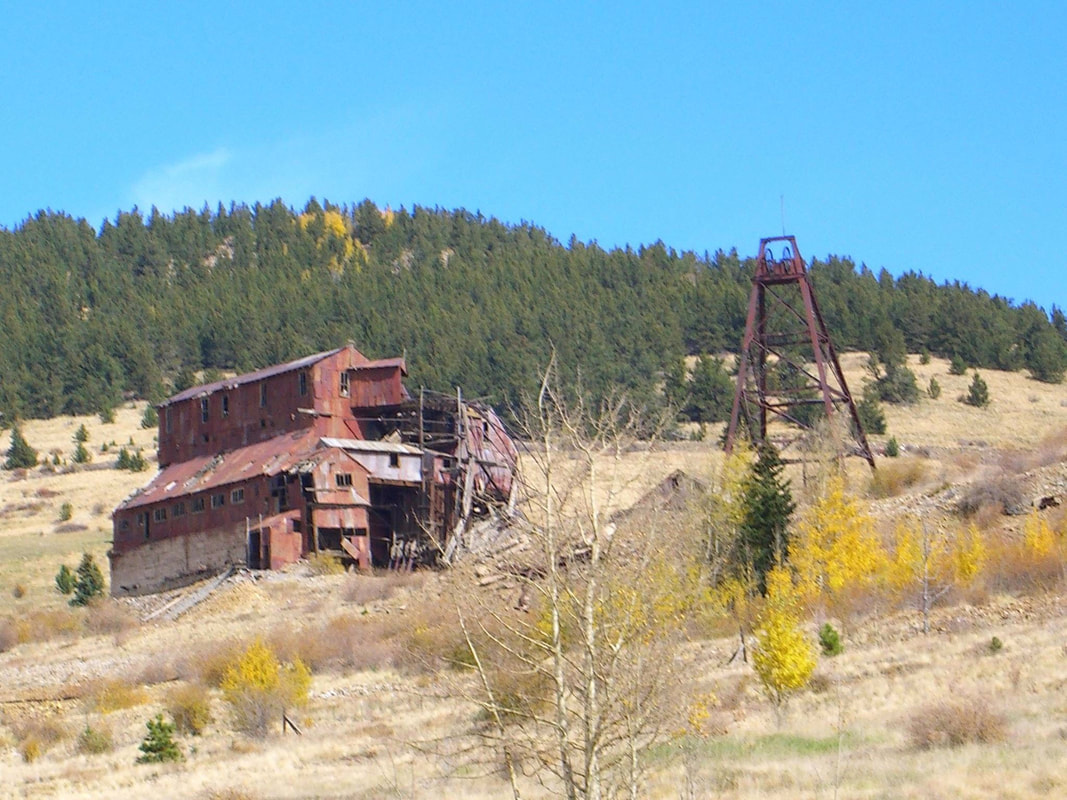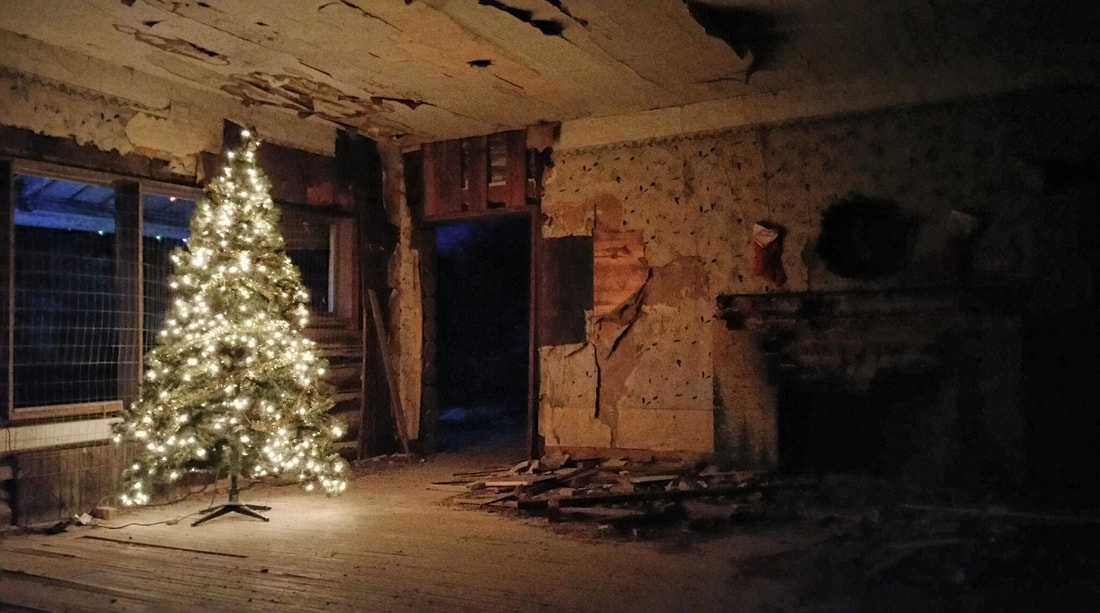Photo Gallery of Historic Underground Gold Mines Near Victor
Before the advent of large scale surface mining, the landscape of the Mining District between Victor and Cripple Creek was dotted with the relics and ruins of four to five hundred underground gold mines that employed thousands of miners all living within a short trolley ride or walking distance from the mines. This photo gallery provides a glimpse of what once was, and what still remains of the more prominent historic underground gold mines near Victor, Colorado.
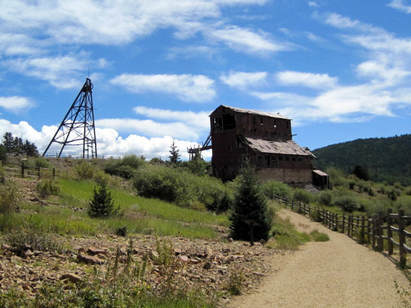 The Vindicator Valley Hiking Trail provides interpretive signage and close-up views of the surviving historical structures that were once part of the Vindicator Mine and numerous other underground gold mines. The nearby historic town site of Independence, CO has been erased by 21st Century surface mining operations.
The Vindicator Valley Hiking Trail provides interpretive signage and close-up views of the surviving historical structures that were once part of the Vindicator Mine and numerous other underground gold mines. The nearby historic town site of Independence, CO has been erased by 21st Century surface mining operations.
THE VINDICATOR MINE: History and Photo Gallery
By La Jean A. Greeson with contributions and edits by Margie King, and contributions with historical photos from Linda Irene Tingvik.
The Vindicator Mine, located near the former town site of Independence in Teller County, Colorado, was the fourth highest producer in the historic Cripple Creek & Victor Mining District. The Vindicator realized gold production of 1,244,000 troy ounces valued at more than $27,000,000. At its peak in 1910, up to 350 miners and 150 lessees worked this property.
By La Jean A. Greeson with contributions and edits by Margie King, and contributions with historical photos from Linda Irene Tingvik.
The Vindicator Mine, located near the former town site of Independence in Teller County, Colorado, was the fourth highest producer in the historic Cripple Creek & Victor Mining District. The Vindicator realized gold production of 1,244,000 troy ounces valued at more than $27,000,000. At its peak in 1910, up to 350 miners and 150 lessees worked this property.
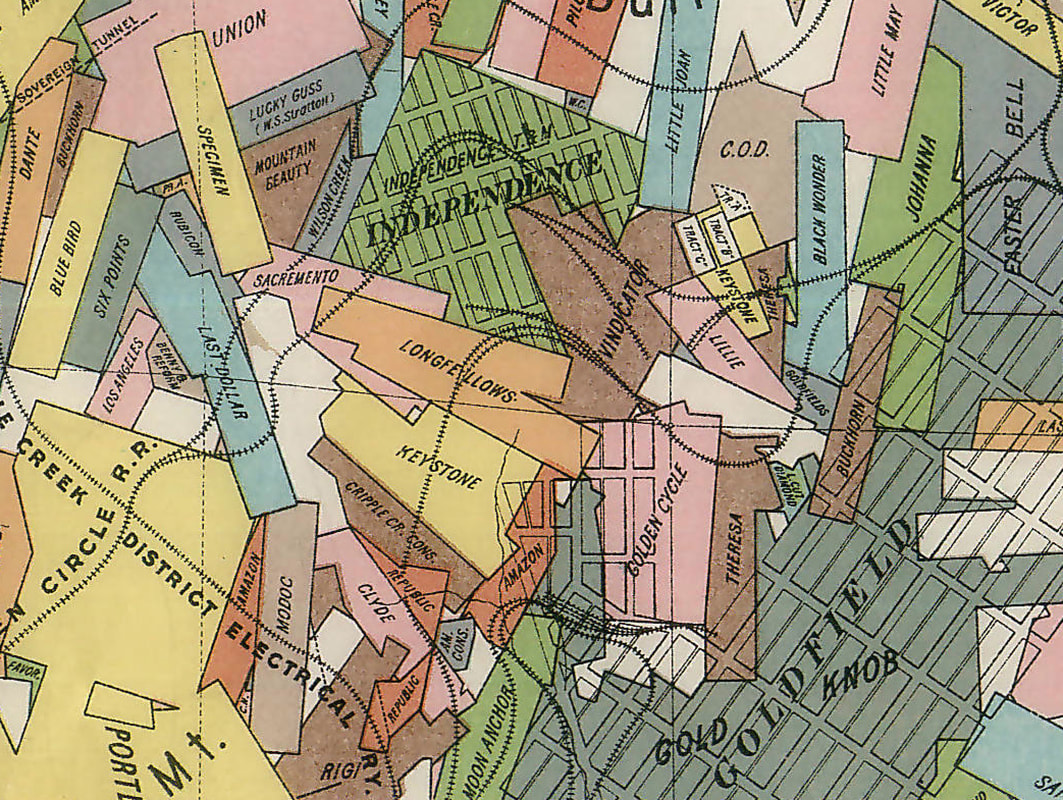
Cropped map shows town site of Independence & surface holdings of the Vindicator & adjoining mining companies in the Cripple Creek Mining District, Teller County, Colorado, compiled expressly for THE OFFICIAL MANUAL OF 1900 by Fred Hills, E.M., Publisher, Colorado Springs, Colo. Map photo contributed by Steve Plutt.
Author Marshall Sprague reported in his book, Money Mountain, that Winfield Scott Stratton viewed the area where the Vindicator was later located, and passed as he deemed it valueless. The mine’s surface altitude sat at 10,210 feet. The underground workings would eventually reach a depth of 2,150 feet. This is more than twice the height of NYC’s Empire State Building.
Establishment of Victor Consolidated Gold Mine
The Vindicator Mining Claim was among four mines surveyed in a March 9, 1896 plat map completed for M. A. Montgomery. The location date for the Vindicator Lode was listed as March 22, 1893.
Not long after gold was discovered in the Cripple Creek Mining District, Denver’s well-known and wealthy brewer, Philip A. Zang, ventured into the mining industry in Cripple Creek and other areas in Colorado. He grubstaked miners in exchange for a piece of their claim. Upon the 1916 death of his son, Adolph Joseph Zang, the September 28th edition of The Denver Post gave insight into the early history of the Vindicator Mine. “When the Vindicator claim was staked, Mr. (Adolph Joseph) Zang and his father were present, and they were on the site when the first trench was dug. It was years before the claim was made to pay, but his faith in the future of the property caused him to put his money into the enterprise with the result that the mine eventually became one of the best properties in the state.”
Mining began on the property in 1895. The Vindicator Consolidated Gold Mining Company was incorporated in December of 1896 with headquarters in Denver.
Establishment of Victor Consolidated Gold Mine
The Vindicator Mining Claim was among four mines surveyed in a March 9, 1896 plat map completed for M. A. Montgomery. The location date for the Vindicator Lode was listed as March 22, 1893.
Not long after gold was discovered in the Cripple Creek Mining District, Denver’s well-known and wealthy brewer, Philip A. Zang, ventured into the mining industry in Cripple Creek and other areas in Colorado. He grubstaked miners in exchange for a piece of their claim. Upon the 1916 death of his son, Adolph Joseph Zang, the September 28th edition of The Denver Post gave insight into the early history of the Vindicator Mine. “When the Vindicator claim was staked, Mr. (Adolph Joseph) Zang and his father were present, and they were on the site when the first trench was dug. It was years before the claim was made to pay, but his faith in the future of the property caused him to put his money into the enterprise with the result that the mine eventually became one of the best properties in the state.”
Mining began on the property in 1895. The Vindicator Consolidated Gold Mining Company was incorporated in December of 1896 with headquarters in Denver.
1896 Founding Directors of the Vindicator Mine
Frederick L. Sigel, President (1846 – 1913)
Guilford S. Wood, Vice President (1851 – 1923)
Frank J. Campbell, Secretary and General Manager (1873 – 1907)
Adolph J. Zang, Treasurer (1856 – 1916)
Peter J. Friederich, Director (1863 – 1911)
Frederick L. Sigel, President (1846 – 1913)
Guilford S. Wood, Vice President (1851 – 1923)
Frank J. Campbell, Secretary and General Manager (1873 – 1907)
Adolph J. Zang, Treasurer (1856 – 1916)
Peter J. Friederich, Director (1863 – 1911)
Photos from Representative Men of Colorado in the Nineteenth Century: A Portrait Gallery, The Rowell Art Publishing Company, Denver, 1902. Google Books.
The Vindicator founding president, Frederick L. Sigel, was originally from Deadwood, South Dakota, and married Miss Anna Zang of Denver in 1879. She was a daughter of Philip Zang. Sigel became linked to his father-in-law’s United Brewing Association, and later, the mining industry. Frederick had additional ties to influential Denver business interests. Although Anna died in 1888, her husband remained a vital part of the Vindicator.
Guilford S. Wood was named the mine’s vice president. After moving to Colorado from Ohio, Wood had business interests in mercantile and contracting ventures with his brother. Guilford then began to conduct business with a new partner, Frank J. Campbell.
Secretary and general manager, Frank J. Campbell came to Colorado from New York seeking relief from asthma. He began in the hardware business in Buena Vista. As with the other directors of the Vindicator, Campbell was connected to mining ventures throughout the Cripple Creek Mining District. He died in 1910 after a brief illness.
Adolph Joseph Zang, founding treasurer, was raised in Kentucky. He studied abroad in his father’s homeland of Germany and came to Denver in 1882 to join the family brewing business. Adolph managed the Zang Brewery and was retained as president and general manager after the company was sold to an English syndicate in 1889. He proudly described himself as a Capitalist. The History of Colorado credits Adolph J. Zang with the establishment of Goldfield, Colorado and the city’s founder.
Peter J. Friederich was listed as a director of the Vindicator, according to The Official Manual of the Cripple Creek District, Colorado, U.S.A. Peter hailed from Illinois and had a family history in the brewing industry. After moving to Denver, he became a collector for the Zang Brewery and married a second of Philip Zang’s daughters, making him the second son-in-law involved with the firm. Peter’s wife, Elizabeth (Zang) Friederich died in 1894. Friederich achieved the 1889 post of assistant general manager of the family-owned Zang Brewery. He died in 1911.
The family patriarch, Philip A. Zang, was a major stockholder of the Vindicator and held wide interests in mines throughout Colorado. He died in 1899, having built a distinguished brewing business and successfully launched his family in the Cripple Creek Mining District. His only son, Adolph, inherited his father’s legacy, businesses, and wealth.
Guilford S. Wood was named the mine’s vice president. After moving to Colorado from Ohio, Wood had business interests in mercantile and contracting ventures with his brother. Guilford then began to conduct business with a new partner, Frank J. Campbell.
Secretary and general manager, Frank J. Campbell came to Colorado from New York seeking relief from asthma. He began in the hardware business in Buena Vista. As with the other directors of the Vindicator, Campbell was connected to mining ventures throughout the Cripple Creek Mining District. He died in 1910 after a brief illness.
Adolph Joseph Zang, founding treasurer, was raised in Kentucky. He studied abroad in his father’s homeland of Germany and came to Denver in 1882 to join the family brewing business. Adolph managed the Zang Brewery and was retained as president and general manager after the company was sold to an English syndicate in 1889. He proudly described himself as a Capitalist. The History of Colorado credits Adolph J. Zang with the establishment of Goldfield, Colorado and the city’s founder.
Peter J. Friederich was listed as a director of the Vindicator, according to The Official Manual of the Cripple Creek District, Colorado, U.S.A. Peter hailed from Illinois and had a family history in the brewing industry. After moving to Denver, he became a collector for the Zang Brewery and married a second of Philip Zang’s daughters, making him the second son-in-law involved with the firm. Peter’s wife, Elizabeth (Zang) Friederich died in 1894. Friederich achieved the 1889 post of assistant general manager of the family-owned Zang Brewery. He died in 1911.
The family patriarch, Philip A. Zang, was a major stockholder of the Vindicator and held wide interests in mines throughout Colorado. He died in 1899, having built a distinguished brewing business and successfully launched his family in the Cripple Creek Mining District. His only son, Adolph, inherited his father’s legacy, businesses, and wealth.
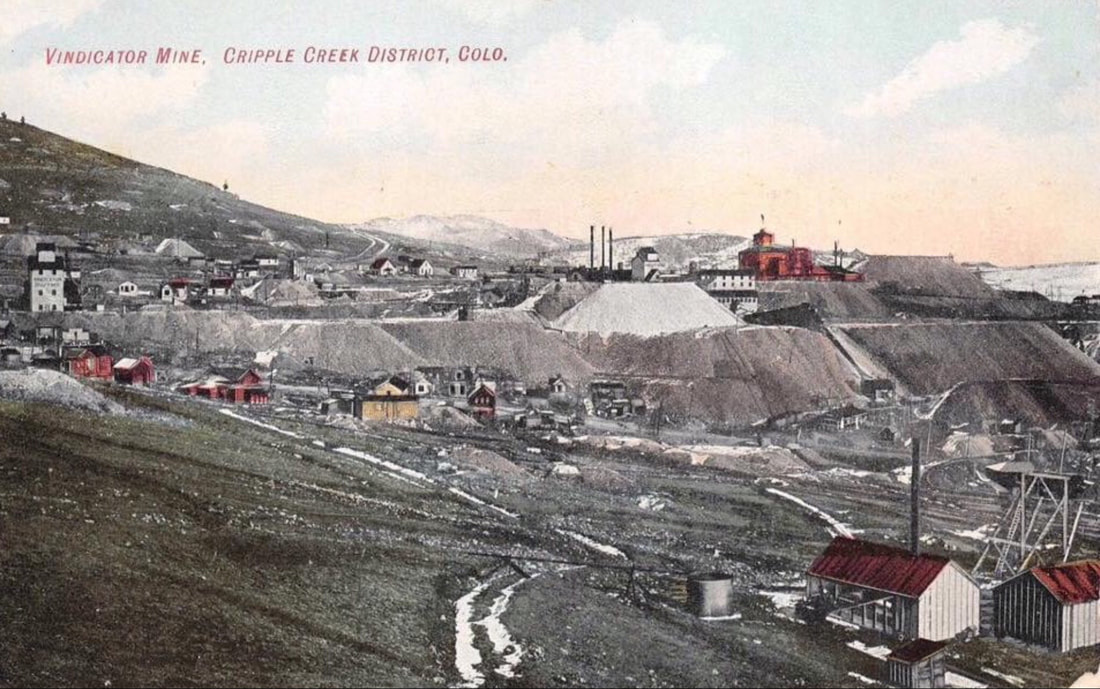
Hand tinted postcard of the Vindicator Shaft No. 2 (white building far left), Shaft No. 1 and Ore House (white buildings on the right with white tailings pile in front). The Lillie Mine (large red structure to the right of the Ore House) was later absorbed by the Vindicator Consolidated Gold Mining Company. The Head Frame and Ore House of the Vindicator Mine and the foundation of the Lillie Mine can be viewed today along the Vindicator Valley Trail. Photo contributed by La Jean A. Greeson.
By 1900, the Vindicator consisted of two shafts, the No. 1 and the No. 2. Fred Hill reported in The Official Manual of Cripple Creek District, U.S.A., “On the No. 1 shaft a new ore house has just been completed at a cost of $12,000, besides water tanks and an electric light plant.” At this time, there were five miles of underground workings, and as with other mines in the District, the Vindicator experienced water problems at the 500-foot level. By 1901, the mine had produced a total of $3,500,000 in gold.
The 1903 dividends for the Vindicator Mine were $1,000,000, of which Adolph Zang personally received one-third. On September 4th of that year, Zang sold his holdings in the Vindicator mine to Dennis Sullivan of Denver for a reported $100,000.
Violence at the Vindicator
During the Western Federation of Miners strike, an explosion at the Vindicator Mine occurred on November 21, 1903. The blast at the 600 foot level proved fatal to Shift Boss Melvin Beck and Superintendent Charles McCormick. Within minutes of being found in the rubble, the men died of their injuries. The explosion was determined to have been the result of sabotage -- a guardrail, when lifted, caused a loaded revolver to discharge into a quantity of dynamite. Pieces of a revolver, along with wire attaching it to the guardrail, were found at the scene of the crime. Prior to descending into the mine, it was thought Beck had been heard telling McCormick there was something suspicious on the 600 foot level.
Violence at the Vindicator
During the Western Federation of Miners strike, an explosion at the Vindicator Mine occurred on November 21, 1903. The blast at the 600 foot level proved fatal to Shift Boss Melvin Beck and Superintendent Charles McCormick. Within minutes of being found in the rubble, the men died of their injuries. The explosion was determined to have been the result of sabotage -- a guardrail, when lifted, caused a loaded revolver to discharge into a quantity of dynamite. Pieces of a revolver, along with wire attaching it to the guardrail, were found at the scene of the crime. Prior to descending into the mine, it was thought Beck had been heard telling McCormick there was something suspicious on the 600 foot level.
Vindicator Shaft No. 2 postcard with Shaft No.1 and Ore House in the background. Photo contributed by Linda Irene Tingvik,
Collection ID P-00286, © CrippleCreekRailroads.Com. http://www.cripplecreekrailroads.com/04library/scnd_postcards_all.php#361
Collection ID P-00286, © CrippleCreekRailroads.Com. http://www.cripplecreekrailroads.com/04library/scnd_postcards_all.php#361
At his trial in 1907, Albert Horsley (a.k.a. Harry Orchard) swore, under oath, that not only was he guilty of the 1905 assassination of former Idaho Governor Frank Steunenberg, he also committed other crimes during the Labor Wars. Orchard testified Western Federation of Miners president, Bill Haywood, paid him $300 to carry out the Vindicator blast. Orchard’s targets were 15 “scab” workers on the 7th level, but through some confusion, he mistakenly placed the explosive device on the wrong level. Many believed that Orchard was not telling the truth and there was speculation some of his crimes had been carried out for the Mine Owners Association to damage the reputation of the WFM.
Elizabeth Jameson reflected the attitude of the Vindicator’s striking miners in her book All That Glitters. They boycotted Zang Beer during the Labor Wars, because the owners had conflicting financial interests. WFM members complained, “They do not want to have union men working on their property, but Mr. Zang wants union members to buy his beer.”
Elizabeth Jameson reflected the attitude of the Vindicator’s striking miners in her book All That Glitters. They boycotted Zang Beer during the Labor Wars, because the owners had conflicting financial interests. WFM members complained, “They do not want to have union men working on their property, but Mr. Zang wants union members to buy his beer.”
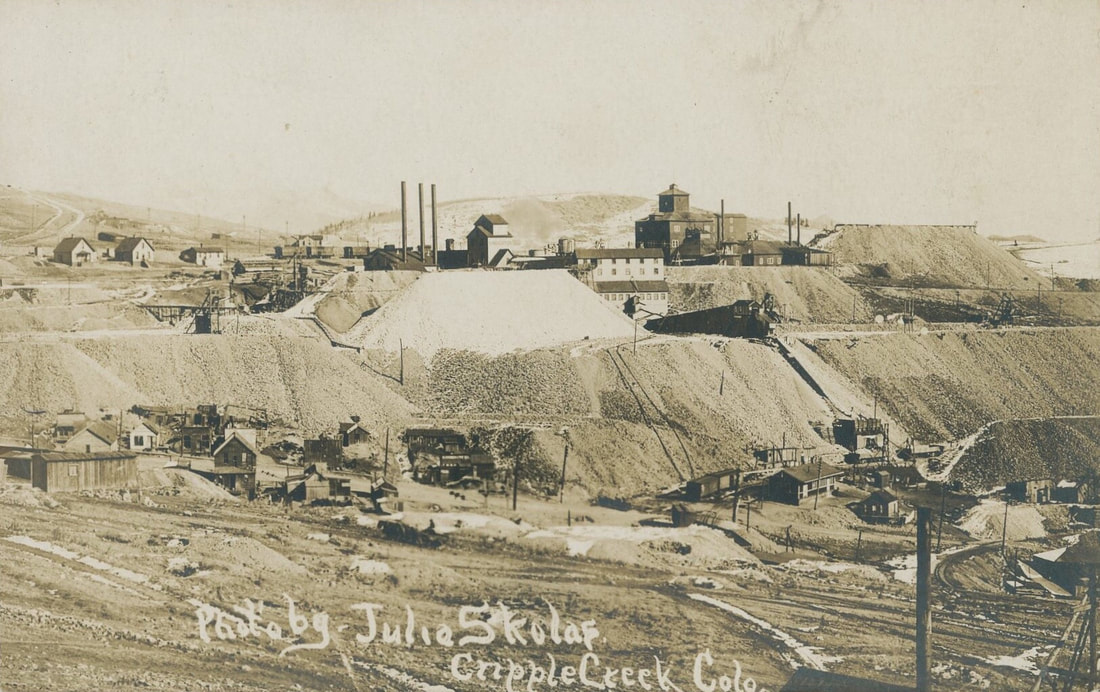
Vindicator Mine Shaft No. 1 with Lillie Mine in background and the town of Independence in foreground. Photo by Julia Skolas, Cripple Creek, Colo. Photo contributed by Linda Irene Tinkvik, Collection ID P-00156, © CrippleCreekRailroads.Com. http://www.cripplecreekrailroads.com/04library/scnd_postcards_all.php#181
Expansion of the Vindicator
The Vindicator Consolidated Gold Mining Company began expansion in 1906. The Independence Town & Mining Company and The Lillie Gold Mining Co. Ltd. were acquired. The Vindicator Valley Mine Surface Plant Marker, located at the present day mine site, tells of continuing improvements: “A bank of four lignite-burning water tube boilers were installed . . . to save on fuel costs. Waste rock was removed from the property by contractors to provide fill for railroad grades. The enclosed, timber gallows frame was replaced by a new steel head frame in 1908.”
The Vindicator Consolidated Gold Mining Company began expansion in 1906. The Independence Town & Mining Company and The Lillie Gold Mining Co. Ltd. were acquired. The Vindicator Valley Mine Surface Plant Marker, located at the present day mine site, tells of continuing improvements: “A bank of four lignite-burning water tube boilers were installed . . . to save on fuel costs. Waste rock was removed from the property by contractors to provide fill for railroad grades. The enclosed, timber gallows frame was replaced by a new steel head frame in 1908.”
The February 24, 1908 edition of The Mining Investor reported the Vindicator Mine completed the most successful year yet, with over 25 miles of underground workings exploring at depths to the 1,000 and 1,200 feet levels. One ton of ore averaged a value of $41, which was very high in the District for that time.
Enhanced 1910 Postcard of the Vindicator Mine Surface Structures of Shaft No. 1. Photo contributed by Linda Irene Tinkgvik,
Collection ID P-03523, © CrippleCreekRailroads.Com. http://www.cripplecreekrailroads.com/04library/scnd_postcards_all.php#6091
Collection ID P-03523, © CrippleCreekRailroads.Com. http://www.cripplecreekrailroads.com/04library/scnd_postcards_all.php#6091
Vindicator president Frederick L. Sigel died in 1913. Adolph J. Zang returned to the Company as president to run day-to-day operations. This was a difficult period as World War I had an impact on the District and caused production to suffer for all mines, including the Vindicator.
In March of 1915, the Vindicator Consolidated Gold Mining Company bought the Golden Cycle Mine for 1.5 million dollars. Cripple Creek banker Albert “Bert” E. Carlton negotiated the sale through the agency of Shove, Penrose and Carlton within 48 hours. This purchase did not include the Golden Cycle Mining and Milling Company’s holdings outside of the District.
In March of 1915, the Vindicator Consolidated Gold Mining Company bought the Golden Cycle Mine for 1.5 million dollars. Cripple Creek banker Albert “Bert” E. Carlton negotiated the sale through the agency of Shove, Penrose and Carlton within 48 hours. This purchase did not include the Golden Cycle Mining and Milling Company’s holdings outside of the District.
▲ Writing on the back of May 1915 photograph contributed by Linda Irene Tingvik Collection, ID P-00481, © CrippleCreekRailroads.Com:
“No. 1 – 2 – 3 are shafts of the Vindicator mine, which is the largest mine here. They work a great many men. Have one mill here and one at the Springs. They are building a new one here that will use the new oil flotation system."
"X Was the Golden Cycle mine, it now belongs to the Vindicator."
"These mines have produced many millions of dollars, nearly as much as the Portland, and have still millions in sight."
"The Cresson mine 2.5 miles east of C. C. is the richest mine in the camp, will send picture of it later. They ship sacked ore under guard worth dollars a pound every month, ore body, ore chute is over 300 ft. wide and 600 ft. long, some of it looks as if it were ½ gold."
"You asked for some pictures of the mines, this is the best we can do right now.”
“No. 1 – 2 – 3 are shafts of the Vindicator mine, which is the largest mine here. They work a great many men. Have one mill here and one at the Springs. They are building a new one here that will use the new oil flotation system."
"X Was the Golden Cycle mine, it now belongs to the Vindicator."
"These mines have produced many millions of dollars, nearly as much as the Portland, and have still millions in sight."
"The Cresson mine 2.5 miles east of C. C. is the richest mine in the camp, will send picture of it later. They ship sacked ore under guard worth dollars a pound every month, ore body, ore chute is over 300 ft. wide and 600 ft. long, some of it looks as if it were ½ gold."
"You asked for some pictures of the mines, this is the best we can do right now.”
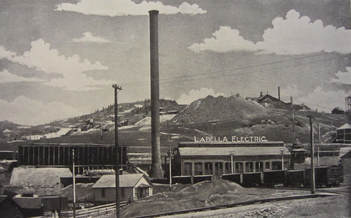 Power Plant of the La Bella Mill, Water & Power Co. Click to enlarge.
Power Plant of the La Bella Mill, Water & Power Co. Click to enlarge.
With this new development of the company, the surface plants and access to the acquired mines were closed. All underground work was conducted solely though the Vindicator shafts.
That same year, the idle La Bella electric generating plant was purchased. It was converted into a small cyanide mill that serviced the Vindicator properties.
That same year, the idle La Bella electric generating plant was purchased. It was converted into a small cyanide mill that serviced the Vindicator properties.
The business relationship between the Zang family and Bert Carlton escalated when, on July 1, 1916, Carlton purchased the Cresson Consolidated Mining and Milling Company. Adolph Joseph’s son, Adolph Frank Zang was appointed as the Cresson’s new secretary. The elder Zang, Adolph Joseph, was listed on the board of directors for the newly acquired company. This is in addition to his concurrent position as president of the Vindicator Mine.
In September that same year, as Adolph J. Zang inspected the Vindicator holdings with the mine’s vice-president, Guilford S. Wood, he suddenly took ill. Zang was stabilized and returned home to Denver, only to die within hours. Wood was elected the new president of the Vindicator Consolidated Gold Mining Company.
Connection to Roosevelt Drainage Tunnel
By this time, the Vindicator was producing only low-grade ore and considered past its prime. Construction on the Roosevelt Drainage Tunnel originally began alleviating water in the mines in 1907. This tunnel’s terminus was to be the Vindicator, but as of 1918, the drainage tunnel had only reached the Portland Mines. It was believed an impervious dike blocked drainage of the Vindicator, requiring pumps to handle 300 gallons of water per minute. In 1920, pumping was temporarily discontinued and water rose up the shaft. In 1921, a tunnel was finally driven 3,000 feet to connect the Roosevelt Tunnel with the Vindicator to dewater the mine.
In September that same year, as Adolph J. Zang inspected the Vindicator holdings with the mine’s vice-president, Guilford S. Wood, he suddenly took ill. Zang was stabilized and returned home to Denver, only to die within hours. Wood was elected the new president of the Vindicator Consolidated Gold Mining Company.
Connection to Roosevelt Drainage Tunnel
By this time, the Vindicator was producing only low-grade ore and considered past its prime. Construction on the Roosevelt Drainage Tunnel originally began alleviating water in the mines in 1907. This tunnel’s terminus was to be the Vindicator, but as of 1918, the drainage tunnel had only reached the Portland Mines. It was believed an impervious dike blocked drainage of the Vindicator, requiring pumps to handle 300 gallons of water per minute. In 1920, pumping was temporarily discontinued and water rose up the shaft. In 1921, a tunnel was finally driven 3,000 feet to connect the Roosevelt Tunnel with the Vindicator to dewater the mine.
Workers at the portal of the Roosevelt Drainage Tunnel during its construction prior to July 1914. Photo contributed by Linda Irene Tingvik,
Collection ID P-03501, © CrippleCreekRailroads.Com. http://www.cripplecreekrailroads.com/04library/scnd_postcards_all.php#6058
Collection ID P-03501, © CrippleCreekRailroads.Com. http://www.cripplecreekrailroads.com/04library/scnd_postcards_all.php#6058
The Portal of the great Roosevelt Deep Drainage Tunnel, prior to 1912. Photo contributed by Linda Irene Tingvik,
Collection ID P-03502, © CrippleCreekRailroads.Com. http://www.cripplecreekrailroads.com/04library/scnd_postcards_all.php#6059
Collection ID P-03502, © CrippleCreekRailroads.Com. http://www.cripplecreekrailroads.com/04library/scnd_postcards_all.php#6059
On July 29, 1921, the Loveland Reporter stated that rock crushers were preparing the Vindicator’s ore dumps for use as a base to pave streets in Colorado Springs and the Cripple Creek / Victor District. A total of 50,000 tons of ore, considered too low-grade for processing due to the high price of shipment, were used for this purpose. Over the years, citizens of the District have taken great pride in telling the world their streets were paved with gold!
Acquisition by Bert Carlton's United Gold Mines Company
Bert Carlton had kept a keen eye on the Vindicator, and on June 9, 1922, his United Gold Mines Company purchased the Vindicator Consolidated Gold Mining Company. At the turn of the century, the Woods family, founders of Victor, had attempted to bring the principle mines in the District under one company’s control, but failed. “Bert” Carlton now held their same dream and was confident he would succeed, having benefitted from Warren, Frank, and Harry Woods’ failed experience.
Carlton’s story is similar to mine owners before him, but there were exceptions to his circumstances and contributions to the District. He arrived in Colorado in 1889, just before the gold boom. Bert was grubstaked by his wealthy father, as was his brother Leslie. Bert suffered from TB and had come west to find the cure in pure mountain air. In the beginning, he did not make plans in advance, telling many he would be gone within a few months due to his poor health. Fortunately, Bert improved with the change in climate and the Carlton brothers founded the Colorado Trade and Transfer Company, hauling coal and ore between Divide and the Mining District.
By 1900, Carlton successfully ventured into the mining business and was considered a potential buyer by Eben Smith and David H. Moffat when they began selling off their mines. As water became problematic throughout the District, a solution was needed to allow deeper mining. Carlton was instrumental in this solution with the Roosevelt Deep Drainage Tunnel project.
From the tunnel’s beginning in 1907, to the completion eleven years later, Carlton persevered. Engineers scoffed at the idea of this impossible enterprise, but Bert never doubted it could be done. Other drainage tunnels had been driven prior to the Roosevelt, but nothing on this scale. Carlton remained loyal to the Cripple Creek Mines, including the Vindicator, long after other owners sold off their interests. He continued to purchase available mines and bought back many he had previously sold. This, at times, meant buying failing mines.
Acquisition by Bert Carlton's United Gold Mines Company
Bert Carlton had kept a keen eye on the Vindicator, and on June 9, 1922, his United Gold Mines Company purchased the Vindicator Consolidated Gold Mining Company. At the turn of the century, the Woods family, founders of Victor, had attempted to bring the principle mines in the District under one company’s control, but failed. “Bert” Carlton now held their same dream and was confident he would succeed, having benefitted from Warren, Frank, and Harry Woods’ failed experience.
Carlton’s story is similar to mine owners before him, but there were exceptions to his circumstances and contributions to the District. He arrived in Colorado in 1889, just before the gold boom. Bert was grubstaked by his wealthy father, as was his brother Leslie. Bert suffered from TB and had come west to find the cure in pure mountain air. In the beginning, he did not make plans in advance, telling many he would be gone within a few months due to his poor health. Fortunately, Bert improved with the change in climate and the Carlton brothers founded the Colorado Trade and Transfer Company, hauling coal and ore between Divide and the Mining District.
By 1900, Carlton successfully ventured into the mining business and was considered a potential buyer by Eben Smith and David H. Moffat when they began selling off their mines. As water became problematic throughout the District, a solution was needed to allow deeper mining. Carlton was instrumental in this solution with the Roosevelt Deep Drainage Tunnel project.
From the tunnel’s beginning in 1907, to the completion eleven years later, Carlton persevered. Engineers scoffed at the idea of this impossible enterprise, but Bert never doubted it could be done. Other drainage tunnels had been driven prior to the Roosevelt, but nothing on this scale. Carlton remained loyal to the Cripple Creek Mines, including the Vindicator, long after other owners sold off their interests. He continued to purchase available mines and bought back many he had previously sold. This, at times, meant buying failing mines.
|
After his sudden death in 1931, Bert Carlton’s brother Leslie assumed management of the company, but Leslie, too, passed in 1938. Bert Carlton’s wife, Ethel, then took the reins. Mrs. Carlton knew what Bert had envisioned for his beloved Cripple Creek and was intent on making that dream come true. In 1935, the government raised the price of gold to $35 an ounce. This boosted production in the District and improved the Vindicator’s profits.
|
Carlton Drainage Tunnel
Mining proceeded to deeper levels, but problems again occurred as they reached water level. Ethel Carlton understood the construction of another drainage tunnel was the only solution to extend mining in the District. According to the Marker at the Vindicator Valley Trail:
“… The Carlton Tunnel, (was) driven in 1939 – 1941, over six miles long. The portal is just below the confluence of Cripple Creek and Four-mile Creek at an elevation of roughly 7,000 feet. The tunnel drained the mines in the southern part of the district enabling the Cresson, Ajax, Portland and many other mines to sink deeper without the hindrance of water. One of the side tunnels or laterals driven from the Carlton, ended directly under the Vindicator Shaft but nearly 1,000 feet below the lowest working of the mine.”
Upon completion of the tunnel, it was then necessary to pump water and increase the depth of the mine to link to the tunnel below. Profiles of the Roosevelt and Carlton Drainage Tunnels are compared in the diagram below.
Mining proceeded to deeper levels, but problems again occurred as they reached water level. Ethel Carlton understood the construction of another drainage tunnel was the only solution to extend mining in the District. According to the Marker at the Vindicator Valley Trail:
“… The Carlton Tunnel, (was) driven in 1939 – 1941, over six miles long. The portal is just below the confluence of Cripple Creek and Four-mile Creek at an elevation of roughly 7,000 feet. The tunnel drained the mines in the southern part of the district enabling the Cresson, Ajax, Portland and many other mines to sink deeper without the hindrance of water. One of the side tunnels or laterals driven from the Carlton, ended directly under the Vindicator Shaft but nearly 1,000 feet below the lowest working of the mine.”
Upon completion of the tunnel, it was then necessary to pump water and increase the depth of the mine to link to the tunnel below. Profiles of the Roosevelt and Carlton Drainage Tunnels are compared in the diagram below.
Carlton Drainage Tunnel Dedication, September 4, 1939, hosted by the Cripple Creek-Victor Kiwanis Club.
Photo contributed by Linda Irene Tingvik, © CrippleCreekRailroads.Com.
Photo contributed by Linda Irene Tingvik, © CrippleCreekRailroads.Com.
The United Gold Mine Company leased out most of its properties to independent contractors until the onset of WWII. In his book, The Lure of Cripple Creek Gold, William Y. Seaman explained the leasing process. “The ‘split-check’ leasing system, adopted first in the Cripple Creek district and now used in all the prominent camps of the country, provides that the company furnishes the power, hoisting, and other facilities, and the leaser furnishes the labor. The net returns from ore extracted is divided equally. The system is given credit for a large part of the general prosperity of the camp.”
WWII Closure, Reopening, & Final Shut Down
While the Carlton Tunnel brought new hope for deeper production, the United States soon entered into WWII following the December 7, 1941 bombing of Pearl Harbor. Many young men left the District to serve their country. On October 8, 1942, the War Production Board issued Limitation Order L-208, forcing the closure of most mines in the District and across the country. Because gold was not deemed essential to the war effort, manpower was directed to production of crucial metals, including copper, tin, lead and zinc.
While the Carlton Tunnel brought new hope for deeper production, the United States soon entered into WWII following the December 7, 1941 bombing of Pearl Harbor. Many young men left the District to serve their country. On October 8, 1942, the War Production Board issued Limitation Order L-208, forcing the closure of most mines in the District and across the country. Because gold was not deemed essential to the war effort, manpower was directed to production of crucial metals, including copper, tin, lead and zinc.
|
◄ In response to the Limitation Order closing down all big gold mines in the nation by Oct. 15, 1942, Kenneth Geddes, the editor of the Times-Record in Cripple Creek posted a notice suspending publication of the newspaper. Editorially, Geddes said, “Our death warrant has been signed. We, Who Are About to Die, Salute You.’"
Geddes wrote "These are scenes Sunday at the famous Colorado mining camp, which has produced almost one-half billion dollars worth of ore since gold was discovered there in 1891. Many of the miners and businessmen already are leaving Cripple Creek to find work or locations elsewhere. Some of them have been forced to leave their families and homes behind, at least temporarily." |
Specimen Mine Ore House postcard, with the Vindicator Surface Buildings in Background. Photo contributed by Linda Irene Tingvik Collection,
ID P-03545, © CrippleCreekRailroads.Com. http://www.cripplecreekrailroads.com/04library/scnd_postcards_all.php#6190
ID P-03545, © CrippleCreekRailroads.Com. http://www.cripplecreekrailroads.com/04library/scnd_postcards_all.php#6190
After the War, the Vindicator continued ore production for a short time. Even so, the mine closed in 1953, briefly reopened in 1956, only to permanently shut down in 1958. The expense of mining far exceeded revenue generated from the price of gold and it became a losing venture. By the mid-1980s, the ore dumps of the Vindicator were sent for processing to recover all remaining gold.
Bull Hill Tailings with the Vindicator (upper left) in 1968, long after mining had ceased.
Photo contributed by Linda Irene Tingvik Collection,ID S-00067, © CrippleCreekRailroads.Com.
Photo contributed by Linda Irene Tingvik Collection,ID S-00067, © CrippleCreekRailroads.Com.
Vindicator Today
Currently the Vindicator, as well as most other consolidated mining property in the District, is controlled by Newmont's Cripple Creek & Victor Mining Company. The abandoned remains of the Vindicator Ore House and Gallows Frame are still visible at their original locations. The Vindicator Valley Hiking Trail has been established for those who would like a glimpse back in time. The landscape has changed over the years, but if one stands quietly along the trail, the ghosts of the past can almost be heard as wind blows through the Vindicator Ore House.
Currently the Vindicator, as well as most other consolidated mining property in the District, is controlled by Newmont's Cripple Creek & Victor Mining Company. The abandoned remains of the Vindicator Ore House and Gallows Frame are still visible at their original locations. The Vindicator Valley Hiking Trail has been established for those who would like a glimpse back in time. The landscape has changed over the years, but if one stands quietly along the trail, the ghosts of the past can almost be heard as wind blows through the Vindicator Ore House.
▲ Photos show Vindicator Ore House Top Car on display at the Western Museum of Mining & Industry in Colorado Springs. After the ore had been hand sorted, the top car would have been on the rails sticking out of the left side of the Ore House. The top car was used to dump refuse ore over the side of the top rail onto the growing tailings pile. When modern mining began in the district, the old refuse piles were taken first, crushed, and any gold was then separated. That is why the rails on the side of the ore house are sticking out into the air. Photos and information contributed by Rick Sauers, Executive Director at the Museum. Click to enlarge.
▲ Vindicator Mine Crew Before 1935. Top row: Butch Herron, Fred Leffler, Frank Playford, Cliff Messer, Ted Weyand, Fred Sullivan, John Tucker. Middle row: J. B. Crowder, Francis Gunn, Doc Ryan, Sid Cottier, Garnet Hosking, Johnie Peters, Louis Weyand, George Lorenz, Art Brannigan. Front row: Russell Sullivan, Clifford, Dick Dawe, Pat Peters, Louie Swanson, Elmer Sullivan, Mickey Fleetwood. Photo and names contributed by Jody Cottier Wells.
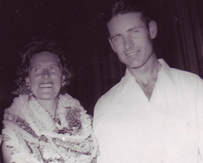 Emma & George Daniel "Bus" Peters (1955), Grandparents of La Jean Greeson.
Emma & George Daniel "Bus" Peters (1955), Grandparents of La Jean Greeson.
A Few Memories--by George Daniel “Bus” Peters (1916 – 2009),
Maternal Grandfather of La Jean A. Greeson.
“I was born in Independence. When I was 17 [in 1933] I started working at the Vindicator, as a miner. I worked at the Vindicator Mine off and on as a miner, electrician, ran the crushing plant, was master mechanic, and at time just a jack of all trades. In the 1930's my top pay was $125.00 a month as master mechanic, and we got paid once a month. Had to get a phone, was on call 24 hours a day. Before that, my day pay was $3.15 a day. The Vindicator Mine was 1700 feet under ground, a tunnel (Carlton) was built and came out at the 2000 foot level, (and) we sunk the shaft to 2100 foot level after the drainage tunnel was built. We had to pump water out of the 2200 level of the mine. Later, other tunnels were built and took care of the water."
"The Vindicator was a short distance from the Independence Post Office. I would go to that post office to get mail for the mine, so I knew Mrs. Rogers, the postmistress. While working at the Vindicator, I went out into the mountains and dug up 2 pine trees and planted them in Mr. Bebee's yard, where they are still growing.”
This story was most likely written in 2006 when my grandfather, George Daniel “Buster” Peters, Jr. was nearing his death at age 92. After the family left Victor in 1956, they lived in Grants, New Mexico, where Grandpa operated G & F Welding and Machine Shop over forty years. For a man who worked all his life, it was devastating to have to close his business due to failing eyesight.
Both sides of Grandpa Bus’ family were in the District prior to the 1900 Census. His father, George, Sr. and his two uncles, John and Charles “Pat,” worked for leasers on Vindicator properties predating the 1917-18 WWI Draft Registration.
In 1931, my 44-year-old great-grandfather, George, Sr., was killed in a mining explosion in Bisbee, Arizona. From 1939 until the tunnel was completed in 1941, Grandpa’s brother, Frank, worked on the Carlton Tunnel. The 1942 WWII Draft Registration cards indicate my great-great uncles, John, age 60, was not employed and “Pat,” at 53, was a self-employed leaser at the Vindicator.
Maternal Grandfather of La Jean A. Greeson.
“I was born in Independence. When I was 17 [in 1933] I started working at the Vindicator, as a miner. I worked at the Vindicator Mine off and on as a miner, electrician, ran the crushing plant, was master mechanic, and at time just a jack of all trades. In the 1930's my top pay was $125.00 a month as master mechanic, and we got paid once a month. Had to get a phone, was on call 24 hours a day. Before that, my day pay was $3.15 a day. The Vindicator Mine was 1700 feet under ground, a tunnel (Carlton) was built and came out at the 2000 foot level, (and) we sunk the shaft to 2100 foot level after the drainage tunnel was built. We had to pump water out of the 2200 level of the mine. Later, other tunnels were built and took care of the water."
"The Vindicator was a short distance from the Independence Post Office. I would go to that post office to get mail for the mine, so I knew Mrs. Rogers, the postmistress. While working at the Vindicator, I went out into the mountains and dug up 2 pine trees and planted them in Mr. Bebee's yard, where they are still growing.”
This story was most likely written in 2006 when my grandfather, George Daniel “Buster” Peters, Jr. was nearing his death at age 92. After the family left Victor in 1956, they lived in Grants, New Mexico, where Grandpa operated G & F Welding and Machine Shop over forty years. For a man who worked all his life, it was devastating to have to close his business due to failing eyesight.
Both sides of Grandpa Bus’ family were in the District prior to the 1900 Census. His father, George, Sr. and his two uncles, John and Charles “Pat,” worked for leasers on Vindicator properties predating the 1917-18 WWI Draft Registration.
In 1931, my 44-year-old great-grandfather, George, Sr., was killed in a mining explosion in Bisbee, Arizona. From 1939 until the tunnel was completed in 1941, Grandpa’s brother, Frank, worked on the Carlton Tunnel. The 1942 WWII Draft Registration cards indicate my great-great uncles, John, age 60, was not employed and “Pat,” at 53, was a self-employed leaser at the Vindicator.
Emma Peters, La Jean's Grandma, described the memorabilia shown in the above photo as follows. “These books are some we got in 1944. They are ration books, needed to buy coffee, sugar, canned goods, tires, gasoline, most everything. First we had to sign up, everybody had to do it. We then received a book for each member of the family. When we shopped we had to take the books with us, without taking any of the stamps out. While ordering the merchant would see if you had enough stamps and the right ones. Then you paid for these items plus your ration stamps. Too bad if you ran out of stamps, before the next ones were issued. Red ones were for meat. Blue for canned goods. Sugar, tires and gasoline were separate books, also coffee. The tokens were tax tokens. Needed them along with the money, when buying anything. The red tokens were change from meat tax.” The lunch box belonged to La Jean's grandfather. He carried it to work every day--including jobs in the Cripple Creek & Victor Mining District, as well as Hawaii and Bisbee, Arizona.
Most families have photos that have special sentimental significance. For the family of Bus and Emma Peters, the photos that follow are treasured because their granddaughter, La Jean Greeson, preserved memories of these structures for Bus and Emma during her visit to the area in 2006 when she viewed the Vindicator Valley for the first time.
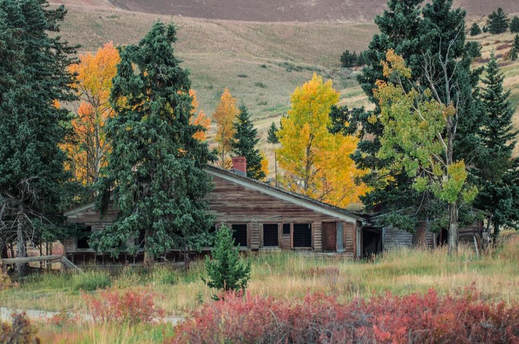 The Alfred H. Bebee house near the remaining Vindicator Mine structures along the Vindicator Valley Trail. Bebee was the Vice-President in Charge of Mining Operations for Golden Cycle, including the Carlton Tunnel. Photo contributed by Jack Sanderson.
The Alfred H. Bebee house near the remaining Vindicator Mine structures along the Vindicator Valley Trail. Bebee was the Vice-President in Charge of Mining Operations for Golden Cycle, including the Carlton Tunnel. Photo contributed by Jack Sanderson.
Vindicator Ghosts of Christmas Past--by Mark Read Moore.
While almost all remnants of the once nearby “Ghost Town of Independence, Colorado” have been erased by time and the advancement of surface mining in the area, the Alfred H. Bebee House still stands at the top of the Vindicator Valley Hiking Trail. Bebee was the Vice-President in Charge of the Golden Cycle Mining Operations (including the Carlton Tunnel).
“In the ghost town of Independence, Colorado, just up Victor Pass from Goldfield, sits an abandoned house in the Vindicator Valley. Each December, this house is visited by festive “spirits” who install a fully lit and garlanded Christmas tree, a wreath and stockings over the fireplace, and external multicolored lights. They even supply a gas-powered generator to power it all. There’s nothing like encountering an abandoned house fully decked out for the season to warm the heart and serve as a reminder that this too was once a happy home. (And still is!)”
While almost all remnants of the once nearby “Ghost Town of Independence, Colorado” have been erased by time and the advancement of surface mining in the area, the Alfred H. Bebee House still stands at the top of the Vindicator Valley Hiking Trail. Bebee was the Vice-President in Charge of the Golden Cycle Mining Operations (including the Carlton Tunnel).
“In the ghost town of Independence, Colorado, just up Victor Pass from Goldfield, sits an abandoned house in the Vindicator Valley. Each December, this house is visited by festive “spirits” who install a fully lit and garlanded Christmas tree, a wreath and stockings over the fireplace, and external multicolored lights. They even supply a gas-powered generator to power it all. There’s nothing like encountering an abandoned house fully decked out for the season to warm the heart and serve as a reminder that this too was once a happy home. (And still is!)”
Festive spirits still decorate the Bebee house at Christmas time. Photos contributed by Mark Read Moore.
Compiled and Submitted by La Jean Greeson, April 2018 -- with thanks to all who contributed and encouraged me to complete this project. Every piece of information has allowed a better understanding and helped preserve the history of the Vindicator Mine in the Cripple Creek & Victor Mining District.
ABOUT THE AUTHOR & CONTRIBUTORS:
La Jean Greeson's family ties to Victor and the Mining District originate before 1900 when her great-great grandparents came to the area. Her grandparents, Buster and Emma Peters, became first-time homeowners in 1940 at 107 Portland Avenue in Victor where their children, Gladys (La Jean's mother) and Pepper, were raised into their teenage years. Bus worked underground in the Vindicator Mine and also helped construct the Carlton Mill for the Golden Cycle Corporation. But frequently he was obliged to seek employment opportunities outside the District--Hawaii (for a tunnel job), and Grants, New Mexico (a uranium mining boom town where he started a welding business). In 1956 the Peters family moved permanently to New Mexico, but returned for visits to their Victor home into the 1970s. La Jean grew up hearing their stories and developed a passion for Victor history that blossomed into a Facebook page featuring historic Victor photos.
La Jean now lives in Bremerton, Washington and visits Victor as often as possible. As an active Victor Heritage Society member, La Jean has generously volunteered to serve as our Family Research Coordinator, and to spearhead coordinating the research and photos for this Gallery of Historic Underground Mines near Victor.
Margie King’s book, A Gold Camp Merry Christmas, highlights the December, 1895 opening of the Midland Terminal Railroad Depot, now home of the Cripple Creek District Museum, publishers of the book. Her career includes Founding Artistic Director of a non-profit, musical theater academy and Assistant Director of Alumni Relations for a California university.
Margie’s Swedish grandfather, Gustaf Nelson, arrived in Victor in 1892, married Matilda Lindblad in 1895, and her father, Glenn Nelson, (youngest of 8 children) was born in 1910. Gus was Assistant Superintendent and Foreman of the Portland Mine, and Alderman and Water Commissioner for the City of Victor. Four brothers also mined at the Portland, and after his 1912 death, his eldest son received dispensation to work for the mine at age 14 to support the family. Gus is buried in the Masonic Section of Sunnyside Cemetery, near the shared grave of his infant, twin daughters. Matilda and her surviving children departed Victor for Denver in 1917, but the Nelson roots remain in the District. Margie’s research for her family history and the Gold Camp has kindled a passion to preserve “THE LAST GREAT GOLD RUSH” in her writings.
Linda Irene Tingvik became fascinated with the mining history and railroads that once served the Cripple Creek Mining District. She has assembled an amazing collection of photos and information that can be viewed through her web site, CrippleCreekRailroads.Com. From her home in Norway, Linda has generously shared her knowledge and many photos featured in this story about the Vindicator Mine. Her passion for the history of the Gold Camp is enhanced by "eyes on" vacation visits to see what it looks like today.
La Jean Greeson's family ties to Victor and the Mining District originate before 1900 when her great-great grandparents came to the area. Her grandparents, Buster and Emma Peters, became first-time homeowners in 1940 at 107 Portland Avenue in Victor where their children, Gladys (La Jean's mother) and Pepper, were raised into their teenage years. Bus worked underground in the Vindicator Mine and also helped construct the Carlton Mill for the Golden Cycle Corporation. But frequently he was obliged to seek employment opportunities outside the District--Hawaii (for a tunnel job), and Grants, New Mexico (a uranium mining boom town where he started a welding business). In 1956 the Peters family moved permanently to New Mexico, but returned for visits to their Victor home into the 1970s. La Jean grew up hearing their stories and developed a passion for Victor history that blossomed into a Facebook page featuring historic Victor photos.
La Jean now lives in Bremerton, Washington and visits Victor as often as possible. As an active Victor Heritage Society member, La Jean has generously volunteered to serve as our Family Research Coordinator, and to spearhead coordinating the research and photos for this Gallery of Historic Underground Mines near Victor.
Margie King’s book, A Gold Camp Merry Christmas, highlights the December, 1895 opening of the Midland Terminal Railroad Depot, now home of the Cripple Creek District Museum, publishers of the book. Her career includes Founding Artistic Director of a non-profit, musical theater academy and Assistant Director of Alumni Relations for a California university.
Margie’s Swedish grandfather, Gustaf Nelson, arrived in Victor in 1892, married Matilda Lindblad in 1895, and her father, Glenn Nelson, (youngest of 8 children) was born in 1910. Gus was Assistant Superintendent and Foreman of the Portland Mine, and Alderman and Water Commissioner for the City of Victor. Four brothers also mined at the Portland, and after his 1912 death, his eldest son received dispensation to work for the mine at age 14 to support the family. Gus is buried in the Masonic Section of Sunnyside Cemetery, near the shared grave of his infant, twin daughters. Matilda and her surviving children departed Victor for Denver in 1917, but the Nelson roots remain in the District. Margie’s research for her family history and the Gold Camp has kindled a passion to preserve “THE LAST GREAT GOLD RUSH” in her writings.
Linda Irene Tingvik became fascinated with the mining history and railroads that once served the Cripple Creek Mining District. She has assembled an amazing collection of photos and information that can be viewed through her web site, CrippleCreekRailroads.Com. From her home in Norway, Linda has generously shared her knowledge and many photos featured in this story about the Vindicator Mine. Her passion for the history of the Gold Camp is enhanced by "eyes on" vacation visits to see what it looks like today.
Sources:
- Bueler, Gladys R. Colorado’s Colorful Characters. Portland OR: WestWinds Press, 1975.
- Colorado Historical Newspaper Collection.
- Ferril, William Columbus. Sketches of Colorado: Being an Analytical Summary and Biographical History of the State of Colorado, Volume 1. 1911. GoogleBooks.Com.
- Hills, Fred. The Official Manual of the Cripple Creek District, Colorado, U.S.A. Colorado Springs, 1900. GoogleBooks.Com.
- Jameson, Elizabeth. All That Glitters: Class, Conflict and Community in Cripple Creek. Chicago: Board of Trustees of University of Illinois Press, 1998.
- Mackell, Jan (Collins). Cripple Creek District: Last of Colorado’s Gold Booms. Charleston SC: Arcadia Publishing, 2003.
- The Mining American, October 7, 1916. GoogleBooks.Com.
- The Mining Investor, Volumes 69 – 70, 1912. GoogleBooks.Com.
- Munn, Bill. A Guide to the Mines of the Cripple Creek District. Century One Press, 1984.
- Representative Men of Colorado in the Nineteenth Century. Denver CO: The Rowell Art Publishing Company, 1902. GoogleBooks.Com.
- Scientific American, Volume 120. April 5, 1919. GoogleBooks.Com.
- Seaman, William Y. The Lure of Cripple Creek Gold. 1916. Library of Congress Digital Collection. Loc.Gov/item/16013661/.
- Sprague, Marshall. Money Mountain: The Story of Cripple Creek Gold. Lincoln, NE: University of Nebraska Press, 1953.
- Stone, Wilbur Fisk. History of Colorado, Volume 3, 1918 and Volume 4, 1919. The S.J. Clarke Publishing Co.
- Tingvik, Linda Irene. CrippleCreekRailroads.Com.
- The Weekly Pioneer Times Morning Review, Deadwood, South Dakota, February 6, 1913.
- Western Museum of Mining & Industry. Rick Sauers, Executive Director. WMMI.Org.
THE PAST MATTERS. PASS IT ALONG. The Next Generation Will Only Inherit What We Choose To Save.
Some people say,
"In a small town there is not much to see, but what you hear makes up for it."
In historic Victor, Colorado there is plenty to see and hear.
Come take a look--and a listen!
Click Here to View the Story of Stratton's Independence Mine
Click Here to View a Photo Gallery Documenting Restoration of the Independence Mine Headframe
Click Here to View the Story of the Gold Coin Mine--Part of the Woods Family Empire
Click Here to View a Photo Gallery: Historic Victor Residential Gems
Click Here to View a Photo Gallery: Victor Businesses Operating in Historic Structures
Click Here to View a Photo Gallery: This Old Victor House/Building--Then & Now
Click Here to View a Booklet: Guidelines for Preserving Our Architectural Heritage
"In a small town there is not much to see, but what you hear makes up for it."
In historic Victor, Colorado there is plenty to see and hear.
Come take a look--and a listen!
Click Here to View the Story of Stratton's Independence Mine
Click Here to View a Photo Gallery Documenting Restoration of the Independence Mine Headframe
Click Here to View the Story of the Gold Coin Mine--Part of the Woods Family Empire
Click Here to View a Photo Gallery: Historic Victor Residential Gems
Click Here to View a Photo Gallery: Victor Businesses Operating in Historic Structures
Click Here to View a Photo Gallery: This Old Victor House/Building--Then & Now
Click Here to View a Booklet: Guidelines for Preserving Our Architectural Heritage
VictorHeritageSociety.com
Copyright © 2023 Victor Heritage Society. All Rights Reserved.
Copyright © 2023 Victor Heritage Society. All Rights Reserved.
